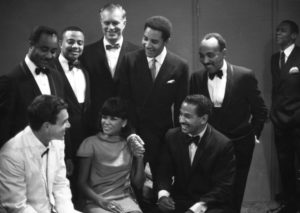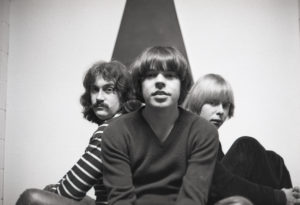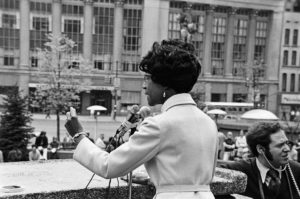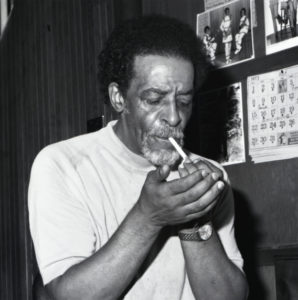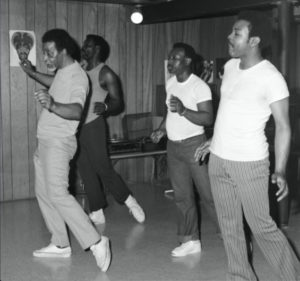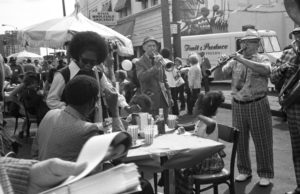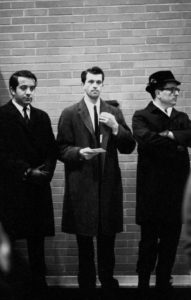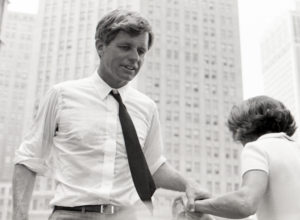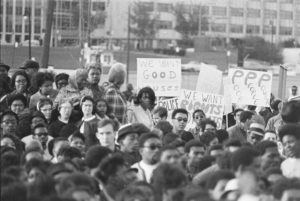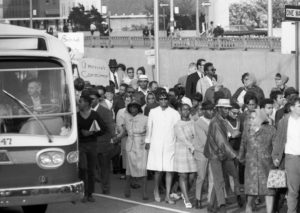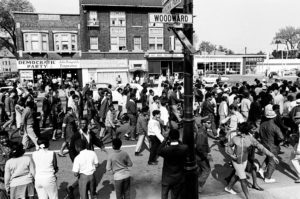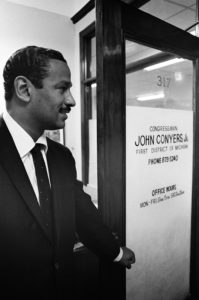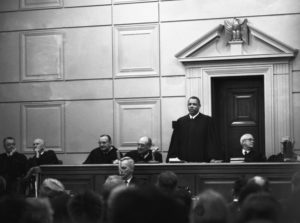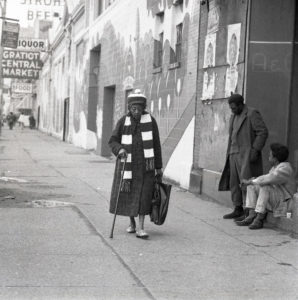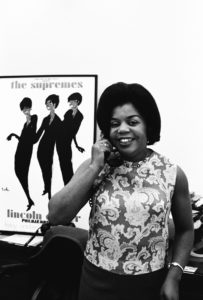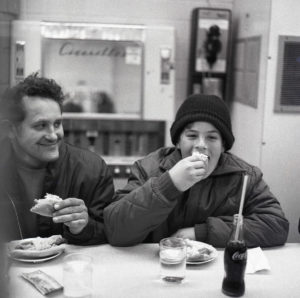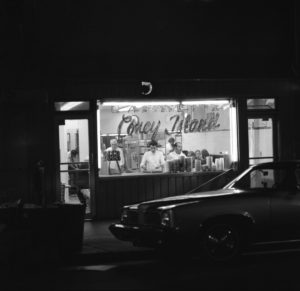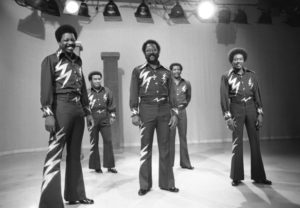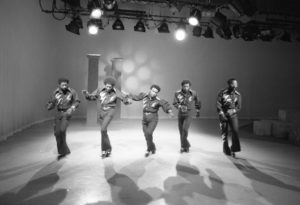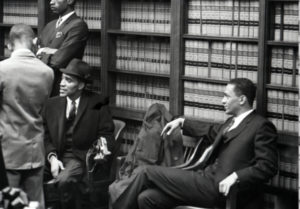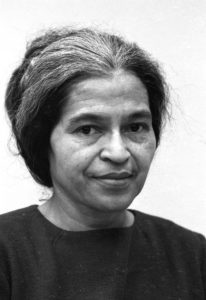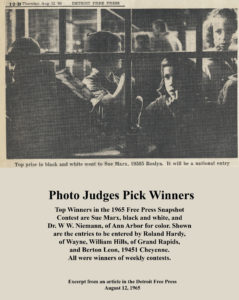Photographs by Sue Marx
Images From History: People Who Defined Detroit in the 1960s
ON EXHIBIT @ THE BBAC THROUGH OCTOBER 8
Click here for a Detroit News article about this exhibit.
Rectangle images: Framed, 21″ x 17″; Unframed (approximate),18″ x 12″
Square images: Framed, 17″ x 17″; Unframed (approximate), 14″ x 14″
Click on an image to see a larger version.
Summer in the City, Mid-1960s
The Paradise Valley and Black Bottom neighborhoods had largely been destroyed by freeway construction and urban renewal. Swimming pools and air-conditioned facilities for Detroit children were in short supply. So on hot summer days, unless the Playmobile showed up, nothing beat playing with your buddies in the street–and just maybe getting a big kid to open up a fire hydrant.
Framed: $450; Unframed Edition (4 Available for Pre-Order): $375
Politics Meets the Arts, c. 1966
Michigan Gov. G. Mennen “Soapy” Williams (at top, with the bow tie) was the only man ever elected to six terms. John Conyers (lower right) would become the longest serving African-American congressman in history. But here, they are part of a group paying court to singer Nancy Wilson (1937-2018) when she was performing in Detroit. That was a good year for Conyers, who went on to be elected to a second term in Congress. Soapy, however, lost his first election ever that fall, a bid for the U.S. Senate.
Framed: $450; Unframed Edition (4 Available for Pre-Order): $375
Bob Seger and The Last Heard, c. 1966
Before the Silver Bullet Band, before he ever grew a beard (or perhaps could) Bob Seger was a Detroit rocker with a band called The Last Heard and a hit single, East Side Story. Though he looks about fourteen here, the future legend was in fact 21.
Framed: $450; Unframed Edition (4 Available for Pre-Order): $375
Making History: Shirley Chisholm, c. 1972
New York Congresswoman Shirley Chisholm (1924-2005) became the first black candidate and the first woman to launch a serious campaign for the Democratic Presidential nomination, and came to Detroit to campaign that year, under her famous slogan, “Unbought and Unbossed.” She didn’t win, but is often seen as having paved the way for both Hillary Clinton and Barack Obama.
Framed: $450; Unframed Edition (4 Available for Pre-Order): $375
Soupy Sales in Detroit, c. 1974
Soupy Sales, aka Milton Supman, (1926-2009) went on to become a nationally known TV personality, but he got his start in the 1950s at WXYZ-TV with a daily kids’ show, Lunch with Soupy Sales, and a nighttime jazz program, Soup’s On. But starting in the 1970s, he came back to Detroit regularly to host a Memorial Day telethon from the Light Guard Armory to raise money for mental health services. His gravestone says, “A Nice Person and a Funny Guy.”
Framed: $450; Unframed Edition (4 Available for Pre-Order): $375
Teaching Motown to Dance: Cholly Atkins, c. 1973
Nobody could dance or teach vocal groups how to dance like the legendary choreographer Charles “Cholly” Atkins (1913-2003) who toured with everyone from Little Anthony and the Imperials to The Supremes. Berry Gordy hired him to teach Motown how to dance on stage in 1964, and the outcome made music history. He continued working with artists from the Four Tops to Gladys Knight well into the 1980s.
Framed: $450; Unframed Edition (4 Available for Pre-Order): $375
Saturday Morning, Eastern Market: c. 1970
Detroiters have been coming to Eastern Market to mingle and buy produce and everything else since 1891. These scenes are from 1970, when the first of the famous murals began going up. The market has grown and fashions have changed, but the scene is still remarkably the same.
Framed: $450; Unframed Edition (4 Available for Pre-Order): $375
Face of Hatred, c. 1968
Right-wing extremist Donald Lobsinger (center) hated The Rev. Martin Luther King, Jr., who he saw as supporting Communism, and he showed up with over 200 members of his group Breakthrough to protest the civil rights leader’s speech at Grosse Pointe High School on March 14, 1968. Lobsinger spent years trying to get the Martin Luther King, Jr. national holiday canceled, at least where he lived in St. Clair Shores, until his own death in November 2018.
Framed: $450; Unframed Edition (4 Available for Pre-Order): $375
Bobby Kennedy in Detroit, c. 1968
Robert F. Kennedy, then a U.S. senator from New York, brought his brief presidential campaign to Detroit in May 1968, soon after his triumphant win in the Indiana primary. He was mobbed by enthusiastic supporters, as was true nearly everywhere he went that spring. Less than a month later, he was assassinated moments after claiming victory in the California Democratic primary.
Framed: $450; Unframed Edition (4 Available for Pre-Order): $375
Martin Luther King, Jr. in Grosse Pointe, c. 1968
The Rev. Dr. Martin Luther King, Jr., an icon of the nonviolent civil rights movement, came to Grosse Pointe High School on March 14, 1968, to deliver a speech called “The Other America.” Here he is being greeted by his old friend, U.S. Rep. John Conyers, then, like King, a youthful 39. In the other photos, he is seen sitting on stage waiting to speak. Exactly three weeks later, King was assassinated in Memphis, Tennessee.
Framed: $450; Unframed Edition (4 Available for Pre-Order): $375
Walk to Freedom March: June 23, 1963
Busloads of citizens arrive for what was, at that time, the largest civil rights march in history. At this Walk to Freedom March, the Rev. Martin Luther King, Jr. delivered an earlier version of the “I Have a Dream Speech” he would subsequently make famous in front of the Lincoln Memorial later that summer. This Detroit march happened nearly twenty years to the date after a 1943 violent response to Black families seeking housing and employment opportunities in the city.
Framed: $450; Unframed Edition (4 Available for Pre-Order): $375
Yusef Lateef: The Maestro in Detroit, c. 1968
The great multi-instrumental jazz performer and composer Yusef Lateef (1920 – 2003) was born in Chattanooga and performed all over the world, but grew up in Detroit. Here he is performing at the Detroit Music Hall and shopping in the city. He was a convert to Islam, had strong ideals, and wouldn’t work where alcohol was sold.
Framed: $450; Unframed Edition (4 Available for Pre-Order): $375
The Fifth Estate, c. 1968
The Fifth Estate, one of the nation’s first underground newspapers, was founded in 1965 by Harvey Ovshinsky at the age of 17 (not pictured). Soon after, its offices moved to Plum Street. Peter Werbe took over as editor, and John Sinclair was the music editor. The paper covered many progressive issues, including strong opposition to the Vietnam War. The Fifth Estate still survives as an online voice under Peter and Marilyn Werbe’s continuing leadership.
Framed: $450; Unframed Edition (4 Available for Pre-Order): $375
A New Congressman, c. 1965
John Conyers, Jr. (1929-2019) became one of only five black members of Congress when he was elected in November, 1964. He would go on to found the Congressional Black Caucus, become Chair of the House Judiciary Committee, and remain a progressive voice in Congress. He served for almost 54 years, longer than almost anyone–except John Dingell–and was the longest serving African-American member of Congress.
Framed: $450; Unframed Edition (4 Available for Pre-Order): $375
John Conyers and Julian Bond, c. 1966
Thanks to the passage of the Voting Rights Act of 1965, a young Julian Bond (1940-2015) became one of the first African-Americans since Reconstruction to be elected to the Georgia House of Representatives. But his fellow representatives refused to seat him because of his opposition to the military draft and the Vietnam War. He visited Detroit, where Congressman John Conyers strongly supported him. Later that year, the U.S. Supreme Court unanimously ruled that Julian Bond was fully entitled to his seat in the legislature.
Framed: $450; Unframed Edition (4 Available for Pre-Order): $375
Standing Up for Justice: Damon Keith, c. 1967
Damon Keith (1922-2019) who served in a segregated army during World War II and once cleaned bathrooms to help pay for law school is shown here soon after President Lyndon B. Johnson appointed him to a seat on the U.S. District Court in 1967. He would go on to issue many landmark rulings, be elevated to the U.S. Court of Appeals, and spend the rest of his long life on the bench.
Framed: $450; Unframed Edition (4 Available for Pre-Order): $375
Neighborhood Scenes, c.1960s
Esther Gordy Edwards, Motown, c. 1965
Say Berry Gordy and everyone immediately thinks “Motown.” But there might not have been a Motown — and there certainly wouldn’t have been a Motown Museum – without his older sister, Esther Gordy Edwards, the legendary “Mother of Motown,” who helped start the label and took an active role in its management.
Framed: $450; Unframed Edition (4 Available for Pre-Order): $375
Willie Horton, c. 1968
Detroit was one of the last major league baseball teams to integrate, and the Detroit Tigers never really had a black superstar until a hometown slugger, Willie Horton, burst on the scene in 1965, showing the awesome power that would help the team to a World Championship in 1968. Today, a state of Willie stands with Ty Cobb and other Tiger immortals behind the outfield at Comerica Park.
Framed: $450; Unframed Edition (4 Available for Pre-Order): $375
Lafayette Coney Island, c. 1967
For more than a century, Detroiters have been chowing down at Lafayette Coney Island, and its next-door rival, American Coney Island, two restaurants started by rival Greek brothers. The pay phone and cigarette machines are gone, and Coca-Cola no longer comes in glass bottles. But the dogs are pretty much the same.
Framed: $450; Unframed Edition (4 Available for Pre-Order): $375
The Spinners, c. 1973
The Detroit group The Spinners had mixed success as a Motown and R&B group in the 1960s, but their career really took off in 1973, with their soul music album The Spinners and their top ten hit signature tune I’ll Be Around. Here, they are seen rehearsing for a Music Hall performance. The group, led by founder Henry Fambrough, is still touring and recording today.
Framed: $450; Unframed Edition (4 Available for Pre-Order): $375
Nate Conyers and Myron Wahls, c.1965
Nathan “Nate” Conyers, right, and Myron “Mike” Wahls (1931-1998) were not as well-known as some Detroiters, notably Nate’s older brother, Congressman John Conyers. But they were highly influential. When this picture was taken, they were partners in the firm Keith, Conyers, Anderson, Brown, and Wahls, but soon afterwards struck out in other directions. Wahls became a Republican and ran unsuccessfully for Michigan Attorney General before being appointed a judge for the Michigan Court of Appeals. Conyers, now 88, went on to run successful auto dealerships and became a close political advisor to both his brother and Detroit Mayor Coleman Young.
Framed: $450; Unframed Edition (4 Available for Pre-Order): $375
The Mother of the Movement: Rosa Parks in Detroit
The modern Civil Rights movement is often said to have begun on December 1, 1955, when a tired seamstress riding a bus home in Montgomery, Alabama refused to give up her seat to a white man. But what many don’t realize is that Rosa Parks (1913-2005) came to Detroit after the success of the Montgomery bus boycott and lived there for more than half her life, working much of that time as secretary, receptionist and assistant for Congressman John Conyers. “You treated her with deference. There was only one Rosa Parks,” he said when she died. If Michigan does replace its statue of Lewis Cass in Washington, could anyone be a more worthy successor?
Framed: $450; Unframed Edition (4 Available for Pre-Order): $375
Window into the Past — and Future, c. 1967
Two young girl scouts are mesmerized by an exhibit at the Henry Ford Museum. Are they thinking about life in the past – or wondering about what they may do with their lives in the future?




